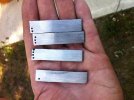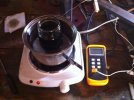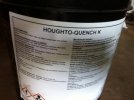- Joined
- Sep 29, 2015
- Messages
- 229
My plan was to practice freehand bevel grinding on some cheap steel but instead of using 1080 I got the brilliant idea to try and see if I could make some hamons so I ordered some 1095 and W2 from Canadian Knife Supply which I was told by them is from Aldo which didn't end up being so brilliant, lol.
From reading the site I learned that these steels need a very fast quenching medium in the 7 to 9 second range. Being in Canada the only way to get Parks 50 was to have it shipped from Texas so I thought I would do some hardness testing using different mediums and testing them with my hardness tester to see if the Parks was really necessary.
In my initial tests I did Brine, a 9 to 11 second oil I got from a local heat treating company for free made by APCO and canola oil all between 130 and 140°F. Just for curiosity I did the 9 to 11 second oil at room temperature also.
My sample pieces were half inch sections cut from a 2 inch by .170 piece of 1095. I have an Evenheat oven with a tap controller. I placed my four pieces in the oven and then ramped up to 1475 and soaked the pieces for 10 minutes.

I tested each sample piece multiple times along its length avoiding the end were my tongs were. I was surprised at the variation along its length. I am thinking this may be due to variations in scale buildup or perhaps uneven bubbling? I know it would be easy to assume my hardness testing is not accurate but whenever I calibrate it with my test piece that came with the unit my reading are within less than one unit accuracy.

But here are my results:
Brine: 64.5, 66.3, 65.5, 66
APCO 9-11 second oil: 54, 60, 65, 65,
Canola Oil: 50, 59, 52
Room Temp APCO 9-11 second oil: 46, 53, 44
The Brine gave me about the results I was hoping for because I had read that a maximum hardness on 1095 after quench was about 66 which in my mind validated that my process was proper.
I was actually surprised that the 9-11 oil gave me up to 65 but the lower numbers down to 54 with it were disheartening and made me think perhaps it was from bubbles forming in some areas or uneven scale as mentioned before. If there is one certainty from this test is that Canola oil isnt up to the job.

The fact that there was such a difference in the 9-11 second oil between the heated and room temperature tests made me think that perhaps there was a sweet spot so I did a further test using this oil at 130°F, 160°F and 190°F as its maximum temperature is 190°F.
130F: 64, 63.5
160F: 60, 61.5, 63.5
190F: 59, 60
The results were mixed but indicate 130°F looks best but compared to a brine quench I am losing approximately 2 Rockwell hardness points so I figured I would invest in a good 7-9 second oil hoping to get back into the 66 range without the risk of cracking from Brine.
I picked up some Houghto-Quench® K - Houghton at a distributor in Stony Creek in the Niagara region of Ontario. I would give the distributors name but I think anyone might want to look at the results before they pick up this stuff.
Just to save on steel I reused the pieces from my previous tests after I did three normalizing cycles in my tests for the Houghto-Quench® K - Houghton. I had pretty dismal results at the three temperatures I tested at which were 140°F, 160°F and finally 180°F. I thought maybe the poor results were from my normalizing cycles so I did a final test using new steel and after reading the only posting on this site about the best temperatures for this oil was between 125°F and 150°F I took the average which was 137 ½°F.
These are the test results using Houghto-Quench® K - Houghton. Again I ramped my oven up to 1475°F which took about one half hour and then soaked it at that temperature for this time 20 minutes to make sure the carbon was fully disbursed.

I took six readings three on each side along the length.
They are: 58, 59, 53, 56, 57, 57
Obviously these are pitiful hardness's for a 7-9 second oil which I was under the impression from reading on this site that I should be getting close to the 66 hardness I got with Brine. This is very disheartening considering I paid almost $300 for this 5 gallon pail that isnt as good as the 9-11 second oil I got for free.
I have a sneaking suspicion that this oil is mislabeled and is not Houghto-Quench® K - Houghton but one of their slower oils? My question is has anyone actually ever tested either 1095 or W-2 using Houghto-Quench® K - Houghton and if so what were the results. Or my other question is does anyone have any suggestions as to what could be my issue?
I know there may be a suspicion that my methods are sloppy but I have been a millwright for almost 30 years where I have spent my career dickering with things and troubleshooting. I really cant see my methodology being at fault especially since my Brine quenches where so good but I am definitely open to criticism. I would love to get to the bottom of this because I really don't know where to go from here? I think I was given the wrong oil mislabelled but how do I prove that? And if not if I spent the money to have Parks 50 shipped up here would i get the same dismal results? Maybe I should just go back to stainless because in the long run it would have been cheaper to practice my grinds on it, lol.
From reading the site I learned that these steels need a very fast quenching medium in the 7 to 9 second range. Being in Canada the only way to get Parks 50 was to have it shipped from Texas so I thought I would do some hardness testing using different mediums and testing them with my hardness tester to see if the Parks was really necessary.
In my initial tests I did Brine, a 9 to 11 second oil I got from a local heat treating company for free made by APCO and canola oil all between 130 and 140°F. Just for curiosity I did the 9 to 11 second oil at room temperature also.
My sample pieces were half inch sections cut from a 2 inch by .170 piece of 1095. I have an Evenheat oven with a tap controller. I placed my four pieces in the oven and then ramped up to 1475 and soaked the pieces for 10 minutes.

I tested each sample piece multiple times along its length avoiding the end were my tongs were. I was surprised at the variation along its length. I am thinking this may be due to variations in scale buildup or perhaps uneven bubbling? I know it would be easy to assume my hardness testing is not accurate but whenever I calibrate it with my test piece that came with the unit my reading are within less than one unit accuracy.

But here are my results:
Brine: 64.5, 66.3, 65.5, 66
APCO 9-11 second oil: 54, 60, 65, 65,
Canola Oil: 50, 59, 52
Room Temp APCO 9-11 second oil: 46, 53, 44
The Brine gave me about the results I was hoping for because I had read that a maximum hardness on 1095 after quench was about 66 which in my mind validated that my process was proper.
I was actually surprised that the 9-11 oil gave me up to 65 but the lower numbers down to 54 with it were disheartening and made me think perhaps it was from bubbles forming in some areas or uneven scale as mentioned before. If there is one certainty from this test is that Canola oil isnt up to the job.

The fact that there was such a difference in the 9-11 second oil between the heated and room temperature tests made me think that perhaps there was a sweet spot so I did a further test using this oil at 130°F, 160°F and 190°F as its maximum temperature is 190°F.
130F: 64, 63.5
160F: 60, 61.5, 63.5
190F: 59, 60
The results were mixed but indicate 130°F looks best but compared to a brine quench I am losing approximately 2 Rockwell hardness points so I figured I would invest in a good 7-9 second oil hoping to get back into the 66 range without the risk of cracking from Brine.
I picked up some Houghto-Quench® K - Houghton at a distributor in Stony Creek in the Niagara region of Ontario. I would give the distributors name but I think anyone might want to look at the results before they pick up this stuff.
Just to save on steel I reused the pieces from my previous tests after I did three normalizing cycles in my tests for the Houghto-Quench® K - Houghton. I had pretty dismal results at the three temperatures I tested at which were 140°F, 160°F and finally 180°F. I thought maybe the poor results were from my normalizing cycles so I did a final test using new steel and after reading the only posting on this site about the best temperatures for this oil was between 125°F and 150°F I took the average which was 137 ½°F.
These are the test results using Houghto-Quench® K - Houghton. Again I ramped my oven up to 1475°F which took about one half hour and then soaked it at that temperature for this time 20 minutes to make sure the carbon was fully disbursed.

I took six readings three on each side along the length.
They are: 58, 59, 53, 56, 57, 57
Obviously these are pitiful hardness's for a 7-9 second oil which I was under the impression from reading on this site that I should be getting close to the 66 hardness I got with Brine. This is very disheartening considering I paid almost $300 for this 5 gallon pail that isnt as good as the 9-11 second oil I got for free.
I have a sneaking suspicion that this oil is mislabeled and is not Houghto-Quench® K - Houghton but one of their slower oils? My question is has anyone actually ever tested either 1095 or W-2 using Houghto-Quench® K - Houghton and if so what were the results. Or my other question is does anyone have any suggestions as to what could be my issue?
I know there may be a suspicion that my methods are sloppy but I have been a millwright for almost 30 years where I have spent my career dickering with things and troubleshooting. I really cant see my methodology being at fault especially since my Brine quenches where so good but I am definitely open to criticism. I would love to get to the bottom of this because I really don't know where to go from here? I think I was given the wrong oil mislabelled but how do I prove that? And if not if I spent the money to have Parks 50 shipped up here would i get the same dismal results? Maybe I should just go back to stainless because in the long run it would have been cheaper to practice my grinds on it, lol.
Last edited:
